Seasonal Affective Disorder and Endurance Athletes
I alluded to this in my last column about skiing, but it hasn’t gone away, so I thought I’d expand on this phenomenon today and see if any readers had suggestions or similar experiences.
Two weekends ago, I had every intention of joining my running club for their regular Saturday morning long run at 8 a.m. I never made it. By the time I finally slothed out of bed, it was close to 9 a.m. I resolved to do a run on my own, hoping for 15 miles on the river — but when I halfheartedly trudged out toward Watertown, I felt listless and succumbed to turning around at the Eliot Bridge, ending up only running seven miles.
Then, this past weekend, I had made a plan to meet three friends Saturday morning at 10 a.m. at the Blue Hills reservation. Knowing that they’d be waiting for me, I couldn’t skip the workout. I made it and got a two-hour run in on the trails. It was spectacular weather and wonderful company, but I lacked any bounce in my stride. It wasn’t as much fun as it should have been.
I think I could have Seasonal Affective Disorder, although I’ve never talked to a professional about it. Perhaps I’m too proud, but I always figure it’s not as important as other problems other people have.
Maybe it’s from the lack of daylight, or the cold temperatures. Maybe it’s the effect of the air quality, from being indoors more often — I don’t know the reason for it. Searches on the internet yield inconclusive answers. But whatever it is, it still affects my training for spring races.
I feel more sluggish in the late winter, sleep more, and have less appetite. My weekly running mileage in the late summer is usually in the 65-80 miles per week range, but in February I struggle to get to 30. My spring races pale in comparison to my fall races.
This has been around for a while. When I think back to high school, I realize that my third quarter grades were never as high as they were for the other academic quarters.
I’ve tried self-remedies. I’ve tried vitamins and tanning booths, sun-lamps, and extra caffeine. Maybe some of these help a little, but I haven’t found a magic bullet. Except, of course, that I usually start feeling better in late March or early April.
In the meantime, I will struggle through it. I find that it helps making definite appointments to meet friends for runs. It helps to break the workouts into smaller manageable bites, 30 minutes in the morning and another 30 minutes at night is more palatable than one 60-minute session. It helps doing as many runs as close to noon as possible (of course I can only do this on the weekends). I also think it helps signing up for organized races, which forces me to train to be in shape for them — I’ve registered for the Marathon in April and have a 50-miler in May.



